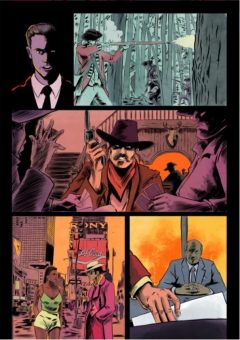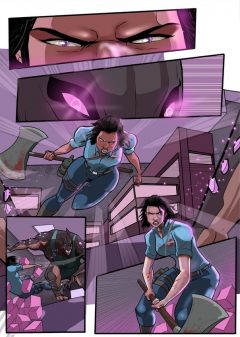“It’s a post-apocalyptic anthology focusing on the humanism in end of the world scenarios” Anthony Pollock discusses Producing The End of the World
Ever wonder what would happen if there was someone orchestrating the last days of mankind? That’s the premise for the new anthology comic from Anthony Pollock (Sodas and Telepaths) and we caught up with him to find out more about his recently launched Kickstarter.
 Recently you launched the Kickstarter campaign for anthology comic Producing at the End of the World (PATEOTW). Can you give us an insight into what it is about and what we can expect to find inside?
Recently you launched the Kickstarter campaign for anthology comic Producing at the End of the World (PATEOTW). Can you give us an insight into what it is about and what we can expect to find inside?
Anthony Pollock: Producing the End of the World is a post-apocalyptic anthology focusing on the humanism in end of the world scenarios. It contains 18 stories created by 18 writers with art by 12 artists. You’ll find an apocalyptic smorgasbord of different artistic styles and stories which range from satire to kaiju’s to multi-headed mutants to clerk employees. We’re confident that there’s something in here for almost any comic book fan.
Where did the idea for Producing come from? Have you always wanted to curate an anthology title?
AP: The idea came from googling post-apocalyptic images over 7 years ago. I’m a sucker for the genre. I came across an image featuring a man in a top hat sitting on a chair looking upon a destroyed post-apocalyptic city. Almost, like he had either caused it or was enjoying the aftermath of the mayhem and was at peace. I held onto this image for a while not knowing what to do with it.
It finally dawned on my late last year… what if that man in the image was producing the very apocalypse that we’re all hoping to avoid as a species? Then it just snow-balled into what it is now.
 What do you think is the secret behind a good anthology? Is it a theme or a consistent character or is it simply the chance to read a wide variety of ideas?
What do you think is the secret behind a good anthology? Is it a theme or a consistent character or is it simply the chance to read a wide variety of ideas?
AP: I can’t necessarily speak to what makes or doesn’t make a good anthology. What I can tell you about is the process I followed and what I like about comic book anthologies. To me, an anthology should be thematic and stay within the bounds of its own ruling system. For me, I decided very early on that this is going to be a post-apocalyptic themed anthology and my pitch to the writers was this: the world has to end at some time. You figure out how that happens but it needs to be in the script somewhere. Also, no zombies. Zombie apocalypses have been done to death. You want zombies? Go read Walking Dead.
One aspect of anthologies I love and this goes back to my absolute fondness of the Heavy Metal Magazine film of the late 70s, my love for the Animatrix in the early 00s and more recently Love, Death and Robots is this – (for the love of god) don’t have the same art style throughout the entire anthology. Especially if you’re creating a multi story anthology over 100 pages long. The art needs room to breathe. You need to find a way to separate one story from the other so that it isn’t disposable.
I understand that the submission levels were massive, did you find it a difficult process to have to ‘weed out’ the ‘winning’ entries?
 AP: I weeded out the submissions based on pitch alone. If you can’t sum up your story in 2 sentences in a cohesive manner then I’m not working with you. It’s that simple.
AP: I weeded out the submissions based on pitch alone. If you can’t sum up your story in 2 sentences in a cohesive manner then I’m not working with you. It’s that simple.
Will you be making a writing debut within the pages of Producing, or are you strictly the editor?
AP: There are 2 stories of mine that are stretch goals in the campaign. If we don’t meet them then that’s fine. I can always just release them in another format in the future. Otherwise, I’m the Editor/Curator and Gary Proudley is the Assistant Editor.
I noticed that you had a special reward level on the Kickstarter, where for half the cost, pledges could receive half of the stories from the anthology. This is a rather unique idea, one I’ve certainly never seen. What was your rationale behind its creation/inclusion?
AP: My rationale is this: creating value. If someone is interested in seeing the anthology but are experiencing some economic difficulty then I want to try and be flexible. That’s what that tier is for. I see plenty of Kickstarters out there which offer a bundle package to receive a random assortment of comics. But I’d argue that doesn’t build a value proposition.
If a prospective backer has visited your Kickstarter campaign page then they’re there for you and what you have to offer. So, in this situation, we have 18 stories on offer… why not offer a prospect 9 of those stories to read? I’d rather they get something new that I’m offering them rather than an assortment of random comics which has been recycled over several different Kickstarter campaigns.
 So, once Producing has been funded (God willing), this will be the final creative venture for your comics website, Soda and Telepaths, which is closing its (virtual) doors. What are your reasons behind the site’s closure? Was it a tough decision? and what are your future plans?
So, once Producing has been funded (God willing), this will be the final creative venture for your comics website, Soda and Telepaths, which is closing its (virtual) doors. What are your reasons behind the site’s closure? Was it a tough decision? and what are your future plans?
I’m looking to venture more into the space of helping creators promote their product and market themselves. It was a bittersweet decision but the outpouring of love from my supporters has made the sting hurt just a little bit less.
I’m still writing. I doubt I’ll ever stop that. Anyone who’s followed Soda and Telepaths can follow my free substack which, for now, has the same name. Over there I’m already starting to engage with content creators on how to sell themselves creatively and that, to me, is very rewarding.
You can pledge your support for Producing the End of the World on Kickstarter here


